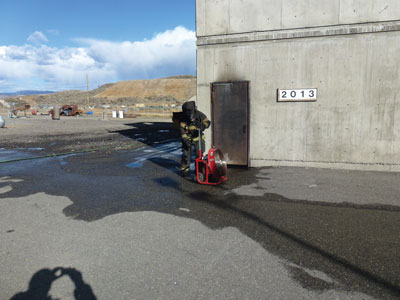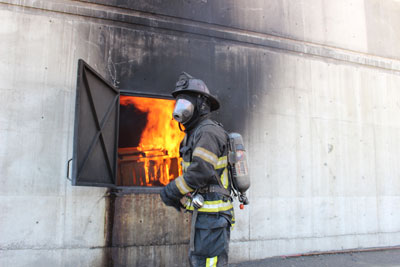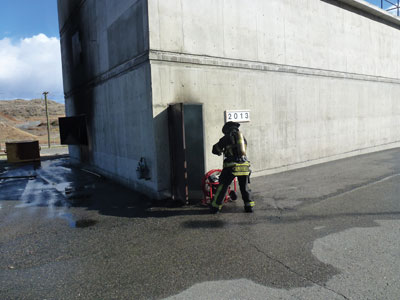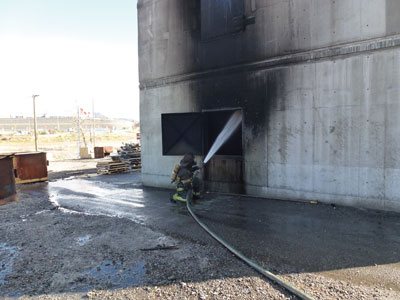
Features
Structural
Training
Exterior fire attack
Having trained with many volunteer fire departments, I have always recognized the need for a minimum-manning emergency-response training program.
November 1, 2012
By Neil Campbell
Having trained with many volunteer fire departments, I have always recognized the need for a minimum-manning emergency-response training program. I have taken a number of courses over the years, trying to find information that I could pass on, but could never find a training program that addressed the issues surrounding a single-engine response to a structure fire with three firefighters on board, and no one else coming any time soon.
 |
|
| Testing has shown that positive-pressure attack is an option for fire departments with minimal manpower at a fire scene. The first step is correct positioning of the positive-pressure fan at the alpha door. Photos courtesy Dynamic Safety Group
|
As a training officer with Kamloops Fire Rescue in British Columbia, I had researched different ventilation techniques and came across positive-pressure attack. We had carried positive-pressure fans on our engines for years, always using the fans to ventilate a structure after the fire was extinguished. The idea of using the fans before the fire was extinguished was something new. Kamloops Fire Rescue began training with positive-pressure attack and the results were amazing: no more crawling through structures trying to find the fire and no more blind primary searches. Using positive-pressure attack, we were entering structures standing up and entering atmospheres hundreds of degrees cooler than before. We were able to find victims quickly because our visibility had improved dramatically. Fire control and extinguishment was quick and less dangerous for our firefighters, as the smoke and super-heated gases had been replaced with cool, fresh air. Flashover potential had all but been eliminated. Kamloops Fire Rescue has been incorporating positive-pressure attack during fire ground operations ever since.
Recently, Kamloops Fire Rescue hosted a training weekend focused on positive-pressure attack. Kriss Garcia (retired battalion chief with the Salt Lake City Fire Department), one of the leading authorities on structural ventilation techniques, was the instructor; I co-instructed. The weekend was full of theory, discussions and hands-on, live-fire training. During the second day of training, one of the students asked if positive-pressure attack could be used with a defensive water application on the fire from outside the structure. With positive-pressure attack, the application of water on the fire is done by firefighters on the inside of the structure, but after a brief discussion, Chief Garcia and I agreed that that we should try positive pressure with an exterior water application.
 |
|
| The second step in positive-pressure attack is to ventilate – in this case the bravo/charlie exhaust.
|
A fire was set in the first floor bravo/charlie corner and a positive-pressure fan was positioned in front of a door on the alpha side. Once the fire was well established, a large window on the bravo side of the structure was opened, as was the alpha-side door. The fan was turned into the doorway and very quickly, effective ventilation through the structure and out the bravo window was achieved. A firefighter positioned outside the structure on the bravo side was instructed to give an indirect water application through the bravo window and into the ceiling of the fire room with a 20-degree fog pattern, then a straight stream water application to the seat of the fire. I had taken position inside the structure in a hallway just outside the burn room. As the hose stream hit the seat of the fire, the water turned to steam. The steam and fire gases filled the room and all visibility in the room went to zero. The steam and fire gases approached the doorway at which I was positioned but because of the positive-pressure attack, the gases were turned back from the hallway and were forced out the bravo window of the burn room. The temperature in the hallway was cool and the visibility was excellent. The fan on the alpha side continued to run and, shortly after, the burn room was completely clear of any heat, smoke or steam. The fire had been extinguished. Further investigation discovered that there was very little smoke or heat found in the rest of the structure. A discussion followed and the chief and I agreed that the extinguishment of the fire from outside the structure while incorporating positive-pressure attack was extremely successful.
This was significant to me, as I had been training with a number of volunteer fire departments and was working on an exterior fire attack program for fire departments with minimum-manning and single-engine response. The issues for these fire departments had always been the same – they don’t get 12, 15 or 20 members to a fire; sometimes, the initial response is three or four firefighters with one engine, with no one arriving to help for another 20 minutes, if at all. For me, the question has always been the same: what can these few firefighters do to control or extinguish the fire from outside, while improving the conditions inside the structure for possible trapped or lost civilians? This new fire-ground tactic offered a solution.
 |
|
| The alpha door has been opened and the positive-pressure fan has been placed in the proper position to achieve effective ventilation.
|
Incorporating positive-pressure attack with an exterior water application is something new to the fire service, but the theory behind it is solid. The theory suggests that the positive-pressure attack would prevent fire, smoke and super-heated gases from traveling throughout the structure, and help to confine the fire. The exterior fire attack would provide fire containment and possible extinguishment, and, as a bonus, no firefighter would have to enter the structure. I conducted training scenarios using this new fire-ground tactic.
The results of the training fires have consistently proved the theory to be accurate. Wooden pallets were used as fuel, taking ceiling temperatures inside the burn room to greater than 1,000 F. The doorway to the adjacent hallway was positioned open.
Temperatures in the hallway exceeded 500 F at chest height, with visibility in the burn room and hallway at almost zero. In each scenario, positive-pressure attack was initiated through a doorway on the alpha side of the structure, with the exhaust opening in the bravo/charlie corner of the structure. Thirty seconds after positive-pressure attack was started, temperature in the hallway adjacent to the burn rooms had dropped to 150 F with visibility improving dramatically, as did the visibility in the burn room. An indirect attack to the ceiling with a one-and-three-quarter-inch hoseline was applied through the exhaust opening in the bravo/charlie corner for 10 seconds, then the hose stream was applied to the seat of the fire. The fire was struck within 60 seconds. During the extinguishment, temperature in the hallway continued to drop and visibility continued to improve. The positive-pressure attack prevented any heat, smoke or steam from leaving the burn room and entering the hallway, instead forcing the gases out of the burn room, through the exhaust opening to the atmosphere.
I contacted Chief Garcia with the findings of the testing I had done. The chief informed me that he had responded to a fire in his community that morning and that the fire had been struck using positive-pressure attack with an exterior extinguishment. Chief Garcia followed up our conversation with an email describing the fire:
* * *
Fire originated in an outside-detached garage and burned into the house located on the bravo side of the garage through an exterior door that was open. This door led into the kitchen.
 |
|
| The final step is to initiate exterior fire attack, in this case through the bravo/charlie exhaust opening.
|
When crews arrived they were faced with a garage fully involved burning into two exposures one being an attached carport on the delta side and the house on the bravo side.
At the same time the main attack line was finishing knockdown in the rear [positive-pressure attack] was initiated at the front door alpha side of the house. The crew member who was extinguishing the garage witnessed a single delta side five-foot by three-foot window fail as the fan was turned into the structure. The firefighter placed a straight stream through the lower half of the window into the kitchen area for a short period of time. The captain watching interior conditions after the fan had been placed noted that the kitchen filled with steam yet the flames that were once in the hallway leading to the bedrooms and front room were no longer apparent.
Within a short period of time the firefighter who hit the fire through the rear window brought the attack line to the front door and made entry, finishing extinguishment of the kitchen and the attic above. During their search, two dogs, both in kennels, were removed from the house with no apparent compromise. The first dog was in the front room with burned paint within 24 inches from the top of the kennel. The other dog was in a bedroom approximately 10 feet away from the kitchen. The hallway leading to the bedroom had extensive paint burns on all sides.
Kriss Garcia
September 2012
* * *
So what does all this mean? Positive-pressure attack incorporating an exterior water application can provide effective fire control while preventing smoke and super-heated fire gases from spreading throughout the structure. Survivability of civilians who maybe inside the structure is improved due to the smoke and super-heated fire gases being exhausted out of the structure quickly and replaced with clean, cool air. Firefighter safety is enhanced due to improved visibility and cooler interior temperatures.
Minimal-man response is a reality for the volunteer fire service. This is a fire-ground tactic that can be initiated by just three or four firefighters with one engine, and is a tactic that can make a significant difference in the outcome of the next fire to which these volunteer and minimum-manning fire departments and their members respond.
More information on exterior fire attack can be found at www.exteriorfireattack.com/
More information on positive-pressure attack can be found at www.positivepressureattack.com/
 |
|
Neil Campbell is an 18-year fire-service veteran and has been a training officer for five years. He is an adjunct Instructor with the Justice Institute of BC. Campbell is a fifth-generation firefighter with the City of Kamloops, a combination career/ auxiliary department, with seven halls, more than 120 career staff and 40 auxiliary staff. Campbell runs Thompson Nicola Fire Training Ltd, and trains volunteer firefighters across British Columbia. Contact him at tnfiretraining@shaw.ca
Print this page